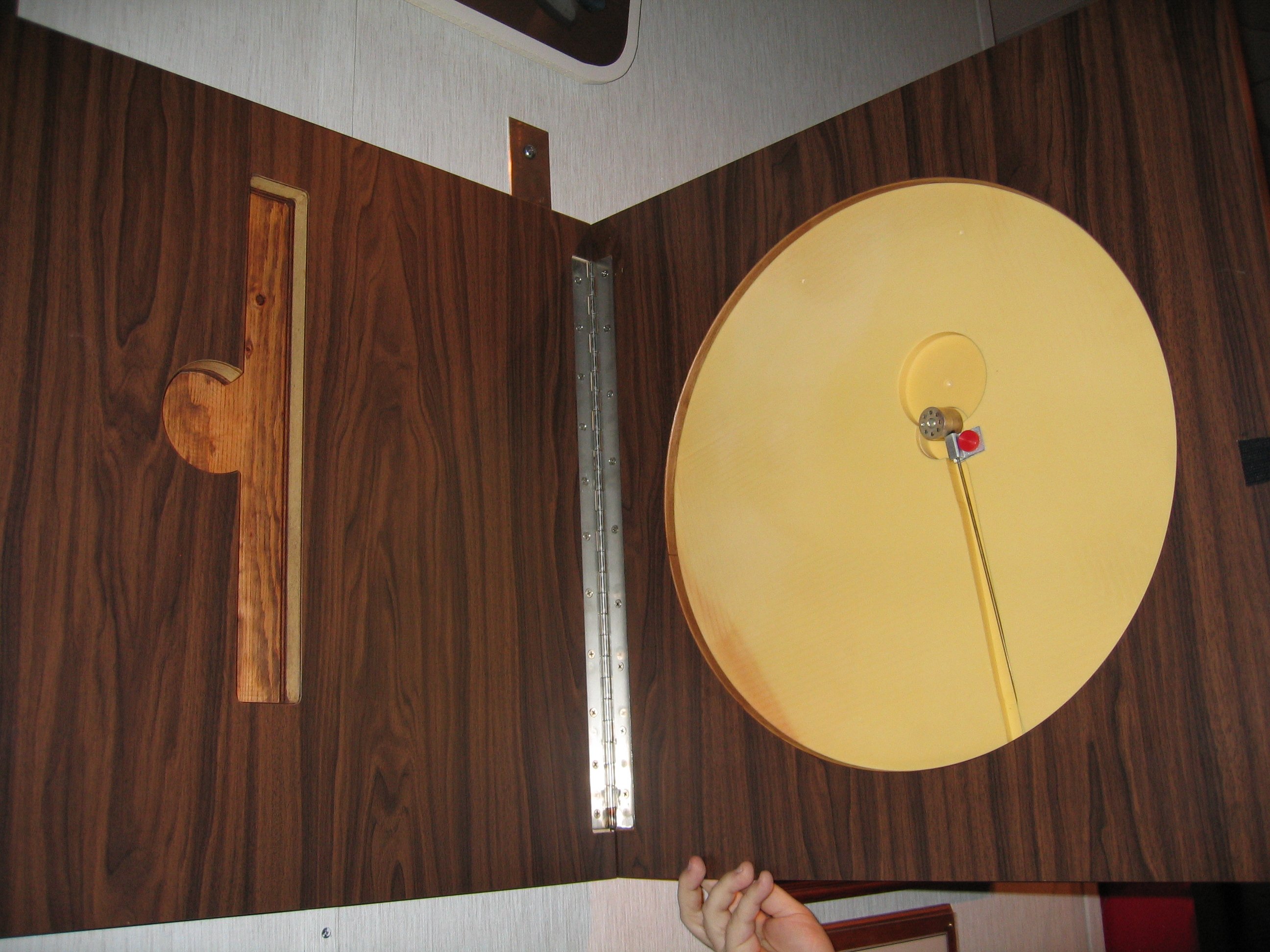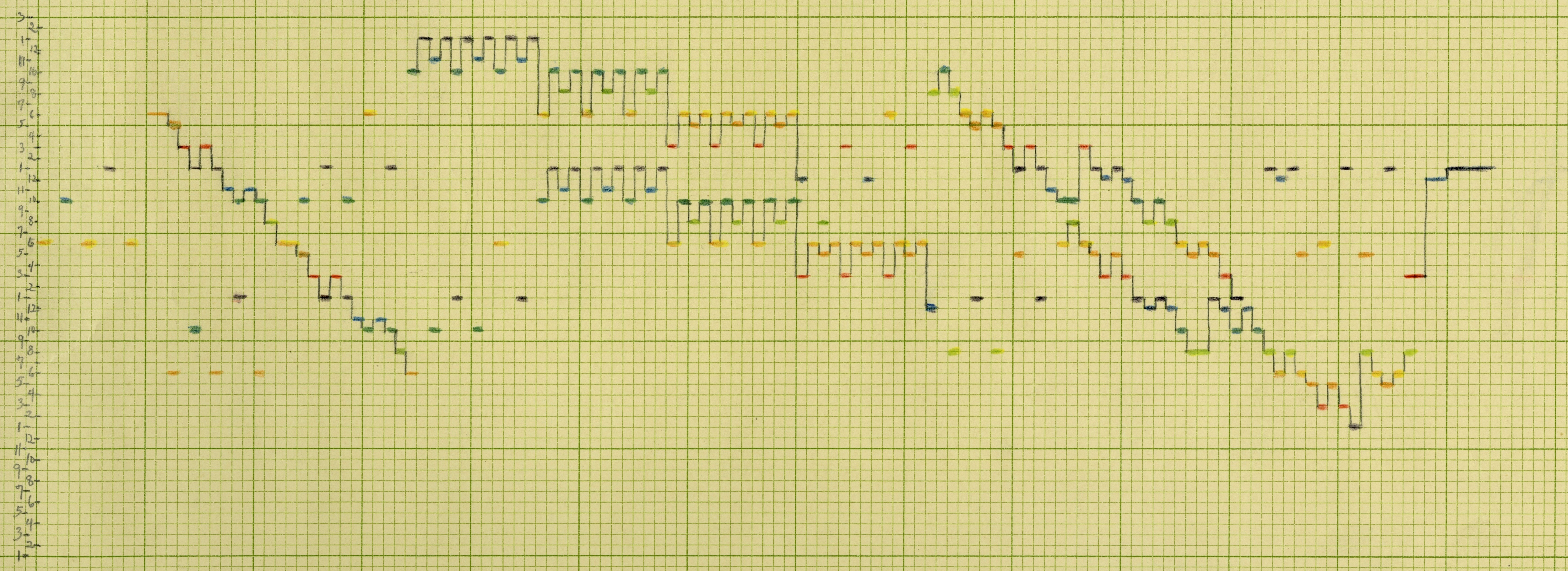|
Rhythmicon
The Rhythmicon—also known as the Polyrhythmophone—was an electro-mechanical musical instrument designed and built by Leon Theremin for composer Henry Cowell, intended to reveal connections between rhythms, pitches and the harmonic series. It used a series of perforated spinning disks, similar to a Nipkow disk, to interrupt the flow of light between bulbs and phototoreceptors aligned with the disk perforations. The interrupted signals created oscillations which were perceived as rhythms or tones depending on the speed of the disks. Although it generated both pitches and rhythms, it has often been described as the world's first drum machine. Development In 1930, the avant-garde American composer and musical theorist Henry Cowell collaborated with Russian inventor Léon Theremin in designing and building the remarkably innovative Rhythmicon. Cowell wanted an instrument with which to play compositions involving multiple rhythmic patterns impossible for one person to perform si ... [...More Info...] [...Related Items...] OR: [Wikipedia] [Google] [Baidu] |
Henry Cowell
Henry Dixon Cowell (; March 11, 1897 – December 10, 1965) was an American composer, writer, pianist, publisher and teacher. Marchioni, Tonimarie (2012)"Henry Cowell: A Life Stranger Than Fiction" ''The Juilliard Journal''. Retrieved 19 June 2022.Campbell, Brett (2014)"Liberating Henry Cowell's Music at San Quentin" ''San Francisco Classical Voice''. Retrieved 19 June 2022. Earning a reputation as an extremely controversial performer and eccentric composer, Cowell became a leading figure of American avant-garde music for the first half of the 20th century — his writings and music serving as a great influence to similar artists at the time, including Lou Harrison, George Antheil, and John Cage, among others.Swed, Mark (2010)"Critic's notebook: Revelatory Henry Cowell revival at Lincoln Center" ''The Los Angeles Times''. Retrieved 19 June 2022. He is considered one of America's most important and influential composers. Cowell was mostly self-taught and developed a unique music ... [...More Info...] [...Related Items...] OR: [Wikipedia] [Google] [Baidu] |
Léon Theremin
Leon Theremin (born Lev Sergeyevich Termen rus, Лев Сергеевич Термéн, p=ˈlʲef sʲɪrˈɡʲejɪvʲɪtɕ tɨrˈmʲen; – 3 November 1993) was a Russian and Soviet inventor, most famous for his invention of the theremin, one of the first electronic musical instruments and the first to be mass-produced. He also worked on early television research. His listening device, " The Thing", hung for seven years in plain view in the United States Ambassador's Moscow office and enabled Soviet agents to eavesdrop on secret conversations. Early life Leon Theremin was born in Saint Petersburg, Russian Empire in 1896. His father was Sergei Emilievich Theremin of French Huguenot descent. His mother was Yevgenia Antonova Orzhinskaya and of German ancestry. He had a sister named Helena. In the seventh class of his high school before an audience of students and parents he demonstrated various optical effects using electricity. By the age of 17, when he was in his last year of ... [...More Info...] [...Related Items...] OR: [Wikipedia] [Google] [Baidu] |
Leon Theremin
Leon Theremin (born Lev Sergeyevich Termen rus, Лев Сергеевич Термéн, p=ˈlʲef sʲɪrˈɡʲejɪvʲɪtɕ tɨrˈmʲen; – 3 November 1993) was a Russian and Soviet inventor, most famous for his invention of the theremin, one of the first electronic musical instruments and the first to be mass-produced. He also worked on early television research. His listening device, " The Thing", hung for seven years in plain view in the United States Ambassador's Moscow office and enabled Soviet agents to eavesdrop on secret conversations. Early life Leon Theremin was born in Saint Petersburg, Russian Empire in 1896. His father was Sergei Emilievich Theremin of French Huguenot descent. His mother was Yevgenia Antonova Orzhinskaya and of German ancestry. He had a sister named Helena. In the seventh class of his high school before an audience of students and parents he demonstrated various optical effects using electricity. By the age of 17, when he was in his last year o ... [...More Info...] [...Related Items...] OR: [Wikipedia] [Google] [Baidu] |
Joseph Schillinger
Joseph Moiseyevich Schillinger ( Russian: Иосиф Моисеевич Шиллингер, (other sources: ) – 23 March 1943) was a composer, music theorist, and composition teacher who originated the Schillinger System of Musical Composition. He was born in Kharkov, in the Kharkov Governorate of the Russian Empire (present-day Ukraine) and died in New York City. Life and career The unprecedented migration of European knowledge and culture that swept from East to West during the first decades of the 20th century included figures such as Prokofiev and Rachmaninov, composers who were the product of the Russian system of music education. Schillinger came from this background, dedicated to creating professional musicians, having been a student at the St Petersburg Imperial Conservatory of Music. He communicated his musical knowledge in the form of a written theory, using mathematical expressions to describe art, architecture, design and music. In New York, Schillinger flourishe ... [...More Info...] [...Related Items...] OR: [Wikipedia] [Google] [Baidu] |
Otto Miessner
William Otto Miessner (May 26, 1880 - May 27, 1967) was an American composer and music educator. Most of his life was spent in the midwest, particularly Indiana and Wisconsin. Life and career Born in Huntingburg, Indiana, Miessner was the son of Charles Miessner and Mary Miessner (née Reutepohler) and the older brother of Benjamin Franklin Miessner. He graduated from Huntingburg High School in 1898. He earned a diploma from the Cincinnati Conservatory of Music, where he studied music theory with A. J. Gantvoort, piano with Frederick Hoffman, and singing with Adolph Devin-Duvivier. He later pursued further studies in New York with Frederick Bristol (singing), A. J. Goodrich (harmony and counterpoint), and Edgar Stillman Kelley (composition). He also studied voice in Berlin, taking lessons in 1910 with Alexander Heinemann. He then taught music from 1900 until 1904 at a school in Boonville, Indiana, before going to Connersville to teach elementary and high school music; he sta ... [...More Info...] [...Related Items...] OR: [Wikipedia] [Google] [Baidu] |
Benjamin Miessner
Benjamin Franklin Miessner (July 27, 1890 – March 25, 1976) was an American radio engineer and inventor. He is most known for his electronic organ, electronic piano, and other musical instruments. He was the inventor of the Cat's whisker detector. Early life and career Miessner was born in Huntingburg, Indiana to Charles and Mary (Reutopohler) Miessner and was the brother of Otto Miessner. He attended school in Huntingburg and graduated from high school in 1908. He then enlisted in the U. S. Navy, and graduated from the U.S. Naval Electrical School in Brooklyn, NY in 1909. He was assigned to a naval radio station in Washington, D.C. to be a radio operator. It was while he was in Washington that he invented the "cat whisker" detector which allowed for receiving radio waves by crystal sets. He was also promoted to Chief Operator. He left the Navy to work with John Hays Hammond Jr. and Frtiz Lowenstein in 1911. The group worked on a wireless control system for torpedoes. ... [...More Info...] [...Related Items...] OR: [Wikipedia] [Google] [Baidu] |
Polyrhythm
Polyrhythm is the simultaneous use of two or more rhythms that are not readily perceived as deriving from one another, or as simple manifestations of the same meter. The rhythmic layers may be the basis of an entire piece of music ( cross-rhythm), or a momentary section. Polyrhythms can be distinguished from irrational rhythms, which can occur within the context of a single part; polyrhythms require at least two rhythms to be played concurrently, one of which is typically an irrational rhythm. Concurrently in this context means within the same rhythmic cycle. The underlying pulse, whether explicit or implicit can be considered one of the concurrent rhythms. For example, the son clave is poly-rhythmic because its 3 section suggests a different meter from the pulse of the entire pattern. In western art music In some European art music, polyrhythm periodically contradicts the prevailing meter. For example, in Mozart's opera ''Don Giovanni'', two orchestras are heard playing t ... [...More Info...] [...Related Items...] OR: [Wikipedia] [Google] [Baidu] |
Wally De Backer
Wouter André "Wally" De Backer (born 21 May 1980), better known by his stage name Gotye ( ), is a Belgian Australians, Belgian-Australian multi-instrumentalist and singer-songwriter. The name "Gotye" is a pronunciation respelling of "Gauthier", the French cognate of his Dutch given name "Wouter". Gotye has released three studio albums Independent record label, independently and one album featuring remixes of tracks from his first two albums. He is a founding member of the Melbourne indie-pop trio The Basics (band), The Basics, who have independently released four studio albums and numerous other titles since 2002. His voice has been compared to those of Peter Gabriel and Sting (musician), Sting. Gotye achieved breakout success with his 2011 single "Somebody That I Used to Know", reaching number one on the Billboard Hot 100, ''Billboard'' Hot 100 and becoming the best-selling song of 2012. This made him the fifth Australian-based artist to top the chart and the second born in Be ... [...More Info...] [...Related Items...] OR: [Wikipedia] [Google] [Baidu] |
Nick Didkovsky
Nick Didkovsky (born 22 November 1958) is a composer, guitarist, computer music programmer, and leader of the band Doctor Nerve.Dorsch He is a former student of Christian Wolff, Pauline Oliveros and Gerald Shapiro. Career Didkovsky formed Doctor Nerve in 1984. He received a Masters in Computer Music from New York University in 1987 and went on to develop a Java music API called JMSL (Java Music Specification Language). JMSL is a toolbox for algorithmic composition and performance. JMSL includes JScore, an extensible staff notation editor. JMSL can output music using either JavaSound or JSyn. He has presented papers on his work at several conferences. Ensemble activities include founding the blackened grindcore band Vomit Fist in 2013. He was a composing member of the Fred Frith Guitar Quartet for the ten years of the band's tenure, and has also played in John Zorn's band. His Punos Music record label is a harbor for his more extreme musical projects such as "split", a guita ... [...More Info...] [...Related Items...] OR: [Wikipedia] [Google] [Baidu] |
Joe Meek
Robert George "Joe" Meek (5 April 1929 – 3 February 1967) was an English record producer, sound engineer and songwriter who pioneered space age and experimental pop music. He also assisted in the development of recording practices like overdubbing, sampling and reverberation. Meek is considered one of the most influential sound engineers of all time, being one of the first to develop ideas such as the recording studio as an instrument, and becoming one of the first producers to be recognised for his individual identity as an artist. Charting singles Meek produced for other artists include " Johnny Remember Me" ( John Leyton, 1961), " Just Like Eddie" (Heinz, 1963), "Angela Jones" ( Michael Cox, 1960), " Have I the Right?" ( the Honeycombs, 1964), and " Tribute to Buddy Holly" ( Mike Berry, 1961). The Tornados' instrumental "Telstar" (1962), written and produced by Meek, became the first record by a British rock group to reach number one in the US Hot 100. It also spent f ... [...More Info...] [...Related Items...] OR: [Wikipedia] [Google] [Baidu] |







